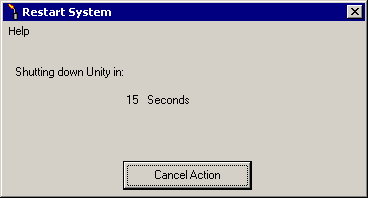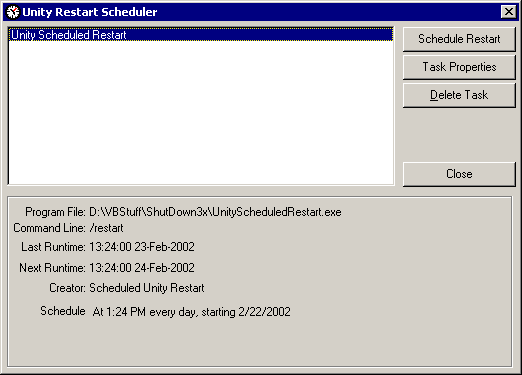Unity Scheduled Restart
Overview
The Unity Scheduled Restart is a simple tool that allows administrators to schedule a time for Unity to shut down nicely and restart the server, just restart the Unity application or just one or more select services.

When you run the Unity Scheduled Restart tool you enter the options dialog above. This allows you to select a time/schedule to restart the Unity server, view the logs of previous restarts or do a test shutdown immediately.
Messages will be written to the application event log indicating the start and completion of each step in the restart process and for any errors encountered.
When a restart is initiated, the following dialog is displayed so an interactive user has an opportunity to abort the process if necessary:

A dialog will pop up with a 30 second countdown before action is taken. If the selected action was to restart the server you’ll see one 30 second countdown before Unity is taken off line and then another dialog will pop up with a 30 second countdown before the server is forced to reboot itself.
A text log of all scheduled restarts is stored in the directory where the Scheduled Restart tool is installed. You can view the log directly or by selecting the “View logs” button on the configuration dialog. Information is also written to the application event log when scheduled restarts are run, see “Scheduling restarts” below for more information on these events.
Requirements/Special Notes
This tool requires Win2K or Win2K3 to run since it integrates with the Windows scheduler service.
Version Compatibility
Any version of Unity Connection 1.1(1) or later.
System Reboot Options
When the Schedule Restart tool is configured to reboot the machine, it first shuts down Unity cleanly and then shuts down SQL and waits for the services to stop. Once that has happened, the REBOOT.BAT file which is installed in the application’s directory is called. By default this runs a Microsoft provided reboot tool called SHUTDOWN.EXE with appropriate command line options to force a reboot in all cases. This option has been tested with many systems and in many configurations and works well under most conditions. However, if you would prefer to use another reboot tool such as the SHUTDOWN.EXE provided in the System32 directory on Windows2003 systems or the original EXITWINDOWS.EXE from the Microsoft resource kit (which also installs into the Unity Schedule Restart directory), you can simply reconfigure the REBOOT.BAT file to call one of these tools.
As a rule, however, the SHUTDOWN.EXE that is setup by default is best – you should only change this if there is a need to do so.
Logging
Each time the Unity Schedule Restart tool is run it generates a new log in the \logs folder under its installation directory. The logs are named “UnityScheduledRestart_Log_YYYYMMDD_HH_MM_SS.txt”. The time used in the hour (HH) field is in 24 hour format. Each time Unity Scheduled Restart tool is run it’ll delete log files older than 30 days found in that directory.
Scheduling a Restart

To schedule a restart, hit the “Schedule Restart” button on the configuration dialog. This will launch the Schedule dialog (above) which interfaces into the built in Windows scheduler. You may see other scheduled tasks in the list that are not related to the Scheduled Restart tool itself. You can edit their properties or delete them from in here but you can only add new tasks specific to the Scheduled Restart Tool via this dialog. Use the Windows Scheduler itself if you want to schedule other types of tasks.
To add a new schedule, hit the ‘Schedule Restart’ button. Provide a display name that will be shown in the schedule list to describe this task. Next, set the properties for the restart task. Do not adjust the path or the command line options, those are set for you automatically. By default the task is not enabled, be sure to check the “Enabled” option at the bottom of the “Task” tab. You set when and how often this task runs on the “Schedule” tab. When you have it configured as you’d like, click “OK”. You will be asked to provide the login name and PW of the account you’d like this task to run under. You can schedule as many different Unity Schedule Restart events as you like.
As noted
above, when scheduled restarts are run the application event log is written to
for each stage of the restart process.
Each log entry has a source of “UnityScheduledRestart” and a category of “Unity Schedule Restart”.
The following event log entries will be written to the Applications
Event log during restarts:
Event ID 1. “Unity Schedule Restart Initiated” – logged when the Schedule Restart tool fires up in shutdown mode. This will be logged either on a scheduled restart or when the user selects the “test restart now” button on the configuration dialog.
Event ID 2, “Unity Shutdown Complete” – logged when all the Unity services have finished shutting down.
Event ID 3, “Unity Restart Initiated” – This message will only be displayed if you have selected to only restart Unity.
Event ID 4, “Server Reboot Initiated” – This message will only be displayed if you have selected to reboot the server.
Event ID 5, “Error encountered
in Unity restart process. Error
reported=xxx”. This will be
logged when any error occurs, including a user intervening and stopping the
restart.
Event ID 6, ”Starting
shut down of service: (service name)”. For each service you’ve asked to
be stopped and restarted this message will be logged at the time the shut down
process starts.
Event ID 7, “Completed shut down of
service: (service name)”. For
each service you’ve asked to be stopped and restarted this message will
be logged at the time it finishes shutting down.
Event ID 8, “Initiating startup of
service: (service name)”. For
each service you’ve asked to be stopped and restarted this message will
be logged at the time it beings the restart process.
Event ID 9, “Completed start up process
for service: (service name)”.
For each service you’ve asked to be stopped and restarted this
message will be logged at the time it finishes starting.
Event ID 10, “Unity Scheduled Restart
completed”. When the entire
service restart process is complete this message will be logged
Choosing a Language Interface
This tool comes with built in support for several languages including US English, French, German and Japanese. By default it will display the language the Windows operating system is set for. If that language is not supported it will default to US English.
To manually force the tool to show a different language than the default, you can select the Help | About menu option and click the “Change Language” hyperlink on the About box. The languages installed will be presented in a drop down list and the display will update into that language immediately when you select it.
NOTE: If you select Japanese as a display language and you are not running on a version of Windows that has the Japanese code page installed, the display will show all “?” characters. This is expected.
Obtaining Updates
To check for updates to this tool, visit http://www.ciscounitytools.com
Revision History
Version 3.0.3 – 5/23/2006
- Fixed several usability issues noted by QA
- Updated copyright info for the 1.2(1) release of Connection
- Fixed a problem with garbage strings in event log output on some installs
Version 3.0.2 – 9/16/2005
- First version for the Cisco Unity connection product line.
© 2005 Cisco Systems, Inc. -- Company Confidential